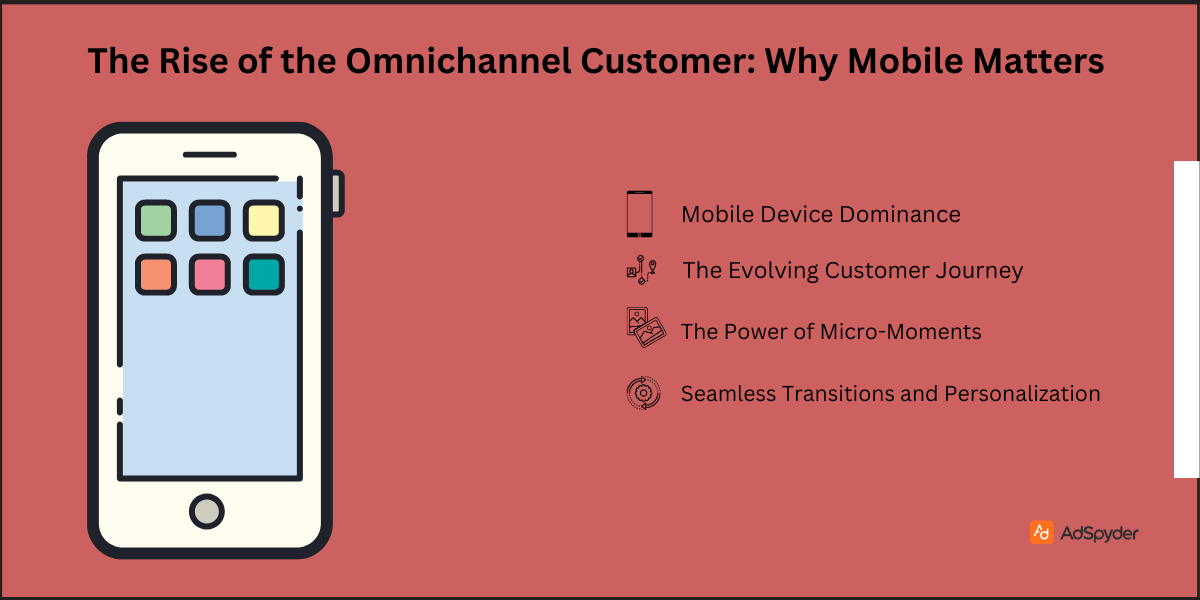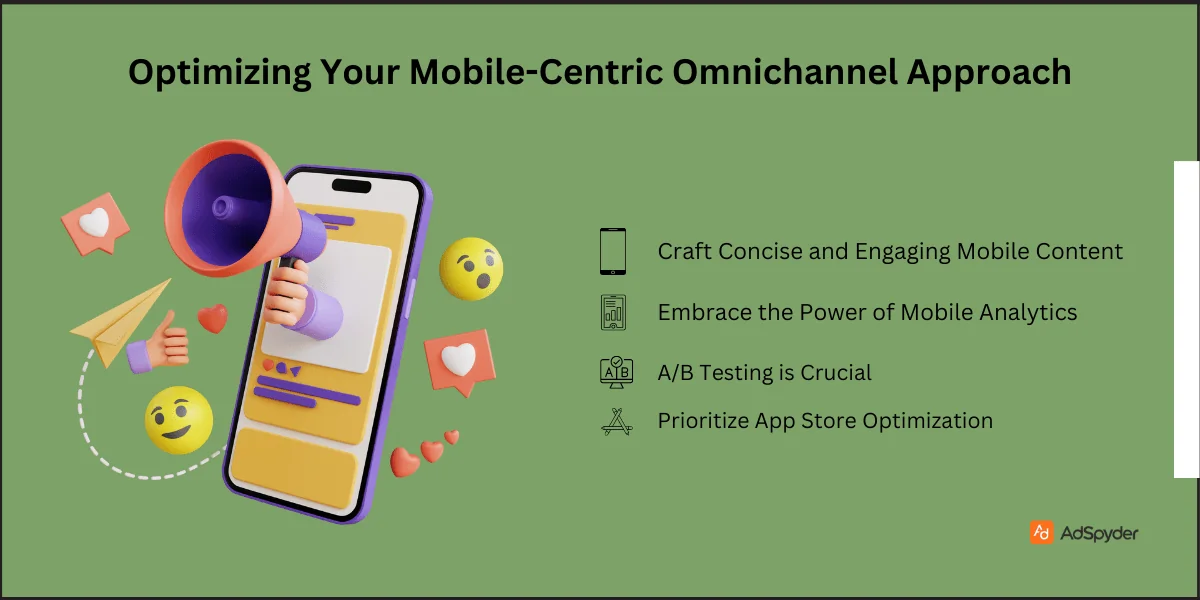Smartphones are considered to be a crucial instrument of the Mobile in Omnichannel Marketing approach focused on reaching out to customers in different environments. What trends of people’s consumption of products and services with the help of portable innovative devices are currently observed, brands should have an effective mobile strategy to target clients from both sides of the digital divide.
Ready to Elevate your Marketing Strategy?
In essence, mobile strategy is the link between the digital and the physical domains, where opportunities like location-based promotions, mobile payments, and continuity are realized. If marketers are to succeed in the modern world, mobile should be seen not as a distinct medium, but as the glue which binds the website, stores, kiosks, and other contact points.
Consumers today are accessing brands on their mobile phones and this is one of the strategic places where brands should meet the customers, especially in emerging markets given the fragmented nature of media.
Summary
This in-depth exploration equips you to harness the power of mobile within your omnichannel marketing strategy:
- Gain insights into the evolving consumer landscape and the rise of omnichannel marketing as a necessity for reaching today’s tech-savvy consumers.
- Explore the numerous benefits of integrating mobile into your omnichannel approach, including enhanced customer experience, improved engagement, and personalized marketing opportunities.
- Discover key strategies for mobile integration, from optimizing your website and app for mobile devices to leveraging location-based marketing and mobile advertising formats.
- Learn actionable tips to optimize various aspects of your mobile marketing efforts, such as crafting mobile-friendly content, promoting seamless transitions between channels, and utilizing mobile analytics for data-driven decision-making.
- Understand the importance of mobile attribution and explore strategies to measure the success of your mobile-integrated omnichannel campaigns.
By following the guidance in this blog, you can develop an omnichannel marketing strategy that seamlessly integrates mobile touchpoints, fostering brand loyalty, driving conversions, and achieving your marketing goals.
The Rise of the Omnichannel Customer: Why Mobile Matters More Than Ever

Today the digital environment has been transformed into a web of interrelated points of contact. Shoppers begin procuring information about a product on one device, benchmark prices on another, and they may finally buy the said product on a third device. It is often a disjointed process in the current environment, and that calls for a strong brand communication framework that ties together the different channels.
Here’s why mobile occupies a central role in omnichannel marketing: Here’s why mobile occupies a central role in omnichannel marketing:
- Mobile Device Dominance: The proportion of people who use smartphones is unprecedented globally. Research has shown that consumer spends most of their time hours utilizing their mobile devices for information, shopping, and brand interaction.
- The Evolving Customer Journey: Generally, the traditionally mapped-out customer journey has become more and more nonlinear and dynamic. It is seen that mobile devices are central to every step starting from the stage of brand awareness and reaching up to the decision-making and even the post-purchase customer interactions.
- The Power of Micro-Moments: Ideal consumers make decisions at the top of their minds and in real-time during the day using their mobile devices. Thus, embracing mobile as one of the components of an omnichannel marketing approach lets a company reach the consumers during those paramount moments that shape their choices and preferences.
- Seamless Transitions and Personalization: Marketing to mobile devices involves a level of customization and immediate communication that was hitherto unthinkable. In its essence, omnichannel marketing utilizes mobile marketing to make transitions between channels smooth and offer custom content according to users’ actions and responses.
Omni-channel marketing with a focus on mobile devices ensures the right targeting with your brand’s marketing messages to the consumer at the most appropriate times.
The Power of Mobile Integration: Key Strategies for Omnichannel Success
Integrating mobile effectively into your omnichannel marketing strategy unlocks a multitude of benefits. Here are some key strategies to consider:
Mobile-Friendly Website Design
- Your website is your digital storefront, and in today’s mobile-first world, it needs to be optimized for smartphones and tablets. Ensure a clean and user-friendly design with fast loading times and responsive design for seamless viewing across all devices.
- For businesses with a mobile app, integrate it seamlessly into your overall marketing strategy. Promote app downloads through your website, social media channels, and mobile ad campaigns. Offer incentives for app downloads and leverage push notifications to engage users and drive in-app activity.
Location-Based Marketing
Mobile devices offer valuable location data.
- Develop location-based marketing strategies to reach users with targeted messaging and promotions relevant to their immediate surroundings.
- Utilize geofencing to send targeted push notifications or display location-specific ads to users near your physical stores or points of interest.
Advertising Formats
Advertising in mobile devices plays a crucial role in reaching new audiences and driving brand awareness. Choose ad formats specifically designed for mobile devices.
- Utilize interactive elements like swipeable carousels or playable ads to capture user attention and encourage engagement.
- Native ads blend seamlessly with the surrounding content on a mobile app or website, offering a less intrusive user experience.
- Leverage video ads or rich media ads with animations and sound effects to create a more immersive and impactful advertising experience on mobile devices.
- Optimize your website and app content for relevant keywords to ensure your offerings appear in search results conducted on mobile devices.
Social Media Marketing for Mobile
Social networks are widely used as the primary human source of information and entertainment on mobile terminal equipment. Develop a mobile-optimized social media strategy that includes:
- Compelling Visual Content: Focus on content such as images, short videos, and graphics that would be relevant for time-starved, mobile-only users scrolling through social media. Use advanced ad campaigns such as Google Performance max. These can use a set of assets and create various ad formats for jsut one ad campaign.
- Storytelling and Micro-Influencers: Social media stories and working with micro-influencers en masse can help to attract a certain segment of the client at the creative platform.
- Interactive Features: Promote interaction by capitalizing on area utilities such as; polls, quizzes, and contests since it helps to engage the audience.
- Social Listening: Take advantage of the social media monitoring tools so that it is easy to know when the brand is mentioned and the opinions of the people.
Seamless Transitions Between Channels
Omni-channel marketing feeds from seamless customer experience making it the best marketing strategy. Ensure a smooth transition between channels by leveraging features like Ensure a smooth transition between channels by leveraging features like:
- Click-to-Call Buttons: Ensure users can call you directly from the interface of their mobile devices by adding large clickable numbers for phones.
- SMS Marketing: Use SMS marketing as an element of your omnichannel approach to deliver texts in the form of exclusive coupons, do not forget about appointments, or there might be updates on the loyalty program.
- QR Codes: Use QR codes where you find anxiety between offline and online channels based on customer comfort. Make them to scan the QR codes on the tangible adverts to get bonus stuff. This can be to download your app, or access your website.
Personalization is Key
Such messages that give specific details such as ‘you’ reflect the call that consumers have to be individualized.
- Use the data gathered from various mobile contact points to customize your marketing communication and promotional tactics relevant to the users’ interests and past actions.
- These can be recommendations of products within an app depending on a user’s choice, emails with offers filtered by history, or promotional messages that are based on a user’s location. For example, for dropshipping businesses, these recommendations provide new ways to introduce your product catalogue.
By implementing these critical tactics, you can ensure proper shifting to mobile marketing. You can achieve a congruent omnichannel strategy that will strengthen business customer relationships and increase conversion rates across the channels.
Optimizing Your Mobile-Centric Omnichannel Approach: Actionable Tips for Success

Effective omnichannel marketing plan, with a focus on mobile, is not a definitive product. It should rather be viewed as an ever-evolving process for continuous improvement. Here are some actionable tips to refine your approach and maximize the effectiveness of your efforts:
Craft Concise and Engaging Mobile Content
- Mobile users are generally impatient and their attention span is relatively short.
- You should write the majority of the content in a clear and straightforward manner.
- Content should adhere to the 5-7 phrase per line guideline, refraining from utilizing complex terminology.
- Incorporating bullet points and concise paragraphs is also helpful. Images and videos should be made to load faster as a result of optimization.
- Try for personalisation based on psychographic segmentation of your audience. You can craft messages based on the behaviours and interest of your target audience segments.
Embrace the Power of Mobile Analytics
- Monitor and report performance indicators that relate to mobile marketing initiatives and the frequency/usage of Websites/Apps.
- Further, it is useful to analyze which channels bring more visitors and those who convert.
- Track which posts your audience is interested in, and where they might ‘get lost’ on a website.
- You can also update your process based on this, for maximum effectiveness.
A/B Testing is Crucial
- Initiate A/B testing to compare the effectiveness of different messages that you want to broadcast on mobile, ads, and landing pages as well.
- For example, you can try using two different headlines and two different CTAs or two different designs of an app icon. See which of them produced better click-through rates, downloads, or conversions.
Prioritize App Store Optimization (ASO)
- If you still have a new-age business that can benefit from a mobile app, work on your app store listing to ensure more traffic gets to the Apple App Store page and Google Play Store page.
- This encompasses such factors as incorporating proper search terms in the title of the app, description, and the meta tag.
- Enhance encouraging remarks and ratings from users of the app.
Invest in Mobile Marketing Automation
- Indeed, the mobile marketing automation system can reduce the workload, schedule the content and messages, and adapt them to individual clients across different channels.
- It puts you in a good position to feed users relevant content or offer promotions at the right time in the customer’s journey.
Omnichannel Measurement and Attribution
- Measuring the success of an omnichannel marketing strategy that integrates mobile touchpoints can be complex.
- However, there are techniques to gain valuable insights
Utilize Multi-Touch Attribution Models
- Go beyond traditional attribution models that only credit the last touchpoint.
- Employ multi-touch attribution models that assign credit to various touchpoints a user interacts with throughout their journey.
- This provides a more holistic view of how mobile contributes to conversions.
Leverage Customer Relationship Management (CRM) Systems
- CRM systems consolidate customer data from various channels, including mobile interactions.
- This allows you to track individual customer journeys and understand how mobile touchpoints influence purchase decisions.
By following these actionable tips and continuously iterating based on data-driven insights, you can optimize your mobile-centric omnichannel marketing efforts. This is to ensure your brand stays at the forefront of consumers’ minds.
FAQs
– Transitioning the user from one channel to another requires care and perfection;
– Determining the effectiveness of mobile as a channel and its ROI;
– Formatting content to fit the micro-screen
– Emphasize journey mapping to provide clients with a coherent experience across mobile and other touchpoints.
– Standardize the messaging and branding to be consistent across both mobile and other channels.
– Think about how the feature will work on each device.
Targeted push notifications based on the position of the customer, QR codes that connect the online and offline worlds, and geofencing in combination with other channels..
Utilize multi-touch attribution models and customer journey tracking tools. This is to understand how mobile interactions contribute to overall conversions and revenue generation. Track key metrics like app downloads, mobile website traffic, etc. This is to gauge the effectiveness of your mobile marketing efforts.
– Check how the content will look like on a small screen
– Plan on how to incorporate the use of videos or any form of interactive content
– Consider how to incorporate personalization by use of data.
The mobile application is helpful but not mandatory for the business. Optimizing your webpage for use on mobile devices and using other forms of mobile marketing such as SMS and mobile advertising are still incredibly effective.
Conclusion
Recap
We presented an analysis of the current customer environment. We also saw the need for marketing through multiple channels to appeal to modern customers. You have explored what we have shared on the multiple advantages of mobile. This ranges from customer experience to interactions and customized marketing. You now know practical strategies to create mobile-compatible content. The blog also showed how to use mobile analytics and A/B testing to boost your marketing. We’ve also looked at the issue of omnichannel measurement and its resolution. The blog mentioned the tips on measuring the success of your mobile-integrated campaigns.
Final Thoughts
The future of marketing is all about brands that adapt to the mobile-first, omnichannel strategy. Today’s consumer demands a well-coordinated and individualized journey, guided by mobile devices. Prioritize mobile integration, use data analysis, and reassess strategies to successfully navigate for mobile. It will also strengthen one’s brand.
Call to Action
Don’t let your competitors steal the mobile marketing edge. Take action now
- Conduct an Omnichannel Marketing Audit: Evaluate the company’s marketing plan you are using at the moment. Determine the gaps and potential in improving the mobile interaction throughout all the advertised channels.
- Develop a Mobile-Centric Omnichannel Marketing Plan: Create a well-coordinated strategy that identifies the organization’s mobile strategy. Give a definition of the various audiences. State how the organization will address the target audience through mobile touchpoints and achieve the marketing objectives.
- Invest in Mobile Marketing Tools and Resources: It is advisable to acquire PR and marketing automation mobile applications, analysis tools, and content creation tools that have been optimized for mobile users.
- Prioritize Mobile Marketing Expertise: Improve your team’s competencies in mobile marketing. Promote among the current employees or try to attract people with experience in mobile marketing strategy and approaches.
- Embrace Continuous Improvement: The mobile marketing environment is very dynamic, with change being the only constant factor. Ensure awareness of the progression of new trends, innovation of new strategies, and utilization of data analysis to continually maximize the effectiveness of your strategy.
Follow these steps and prioritizing a mobile-centric omnichannel marketing strategy. Reach your target audience where they spend most of their time – on their mobile devices. This will allow you to drive engagement and conversions. Achieve your marketing objectives in the mobile-first world.




